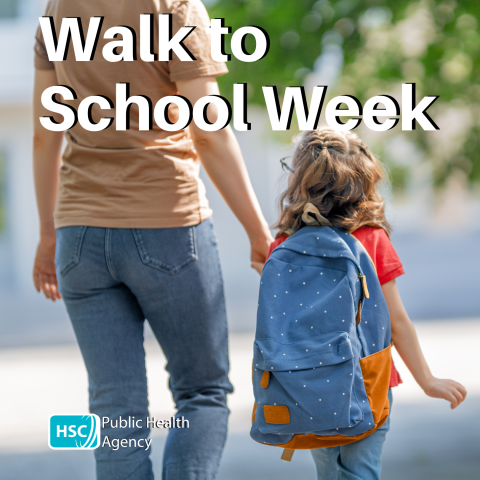Forget the car and walk to school

Next week (15-19 May) is Walk to School Week and the Public Health Agency (PHA) is encouraging everyone to get more active by leaving the car at home and walking the school run.
Statistics show that almost two thirds (65%) of primary school pupils are driven to or from school by car, while around a quarter – only 26% – walk. For post-primary, 35% of pupils are driven by car and just 16% walk.
When compared with stats from 2013/14, car travel to and from primary school has increased by 6% (59% to 65%) and walking has decreased by 5% (31% to 26%).
Colette Brolly, the PHA lead on physical activity, said: “It’s important that children are introduced to a culture of being active from an early age as it is something that will stay with them and benefit them throughout their lives.
“Half of our primary school pupils live a mile or less from their school but far too few of them are walking or cycling to school.
“The great thing about walking is that it is simple and easy to do. It’s something that can be built in to your everyday routine and there’s no better way to get started than walking to school with your kids.
“Walk to School Week gives us all the opportunity to get active, and it’s not something that’s just for kids. Make this a family experience and walk with your children or grandchildren to school. It won’t feel like exercise at all and you will all get to spend that special time together, as well as becoming more active.”
Being physically active helps to build strong bones, muscles and a healthy heart, supports the development of social skills, and encourages a sense of wellbeing.
The PHA, along with the Department for Infrastructure, funds the Active Schools Travel programme.
The programme, delivered by Sustrans, encourages and supports school pupils to walk, cycle or scoot to school rather than taking a lift in the car with their parents.
The Chief Medical Officers recommend that children over the age of five years need to take part in moderate to vigorous intensity activities for at least 60 minutes, and up to several hours, every day. This can be broken up into small chunks of 10 minutes throughout the day – it all adds up.
For adults, walking at a brisk pace can make you feel good and reduce anxiety, can help you sleep better, and can reduce blood pressure, and with 63% of men and 58% of women being overweight or obese in Northern Ireland, walking to school with your children can also help you manage your weight.
For further information on the benefits of walking and tips and hints to get started visit the PHA’s website www.ChooseToLiveBetter.com
- Statistics on travel to and from school 2015/16 can be found on the Department for Infrastructure website – www.infrastructure-ni.gov.uk/publications/travel-tofrom-school-by-pupils-ni-202122
- In primary schools, for main mode of travel, almost two thirds (65%) were driven to/from school by car and 26% usually walked. A further 7% took a bus, and 1% cycled to and/or from school.
- Half (50%) of primary school pupils live a mile or less from school and of these, almost half were driven to school by car and 48% walked to school.
- Amongst post-primary school pupils, 45% travelled to/from school by bus as their main mode of travel, and a further 35% travelled to/from school by car. Less than one in five (16%) pupils walked to/from school, while a small proportion took the train (1%).
- For post-primary school pupils, 54% lived between more than 4 miles from their school. Of these pupils, two thirds (66%) travelled by bus and 29% were driven by car.
- The Health Survey for Northern Ireland 2019-20 is the latest health survey to contain statistics for overweight and obesity. This can be found at www.health-ni.gov.uk/publications/health-survey-northern-ireland-first-results-201920
